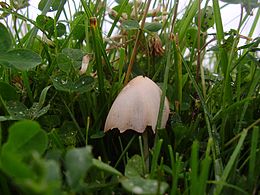- Conocybe apala
-
Conocybe apala 
Conocybe apala Scientific classification Kingdom: Fungi Division: Basidiomycota Class: Agaricomycetes Subclass: Hymenomycetes Order: Agaricales Family: Bolbitiaceae Genus: Conocybe Species: C. apala Binomial name Conocybe apala
((Fr.) Arnolds, 2003)Conocybe apala Mycological characteristics 
gills on hymenium 
cap is conical 

hymenium is adnexed
or free
stipe is bare 

spore print is brown
to reddish-brown
ecology is saprotrophic 
edibility: inedible Conocybe apala is a basidiomycete fungus and a member of Conocybe. It is a fairly common fungus, both in North America and Europe, found growing among short green grass. Until recently, the species was also commonly known as Conocybe lactea and Conocybe albipes.[1] Other common synonyms such as Bolbitius lacteus J.B.E. Lange 1940 and Bolbitius albipes G.H. Otth 1871, place the fungus in the genus Bolbitius.
Contents
Appearance
Easily missable due to their very small size, C. apala fruitbodies are otherwise quite easy to identify. The cap has a pale cream to silvery-white colour and may sometimes have a darker yellow to brown coloration towards the central umbo. Its trademark hood-shaped conical cap expands with age and may flatten out, the surface being marked by minute radiating ridges. The cap can be up to 3 cm in diameter. The gills may be visible through the thin cap and these are coloured rust or cinnamon brown and quite dense. They are adnexed or free and release brown to reddish-brown elliptical spores producing a spore print of the same colour. The stem is cap-coloured, elongated, thin, hollow and more or less equal along its length with a height up to 11 cm and diameter 0.1 to 0.3 cm.[2][3] It can bear minuscule striations or hairs. The flesh of C. apala has no discernible taste or smell.
It must be stressed that all parts of this small, light fungus are extremely delicate and fragile. The slender stem enables the mushroom to compete with vegetation for access to air currents for spore dispersal.
Habitat
C. apala is a saprobe found in areas with rich soil and short grass such as pastures, playing fields, lawns, meadows as well as rotting manured straw, fruiting single or sparingly few ephemeral bodies. It is commonly found fruiting during humid, rainy weather with generally overcast skies. It will appear on sunny mornings while there is dew but will not persist once it evaporates. In most cases, by midday the delicate fruiting bodies shrivel, dry and fade from sight. C.apala's fruiting season begins in spring and ends in autumn.[2] It is distributed across Europe and North America.[4]
Edibility
C. apala does not bear a distinctive taste or smell. While it is widely quoted as inedible and worthless[2][3] due to its small size and mass, it is suspect for toxicity according to at least one author.[4] Other members of the Conocybe genus, like Conocybe filaris, are toxic.
External links and resources
- ^ Index Fungorum - Names Record
- ^ a b c "Conocybe albipes at Mushroom Expert". Mushroom Expert. http://www.mushroomexpert.com/conocybe_lactea.html. Retrieved July 16, 2009.
- ^ a b M. Jordan (1995). The Encyclopedia of Fungi of Britain and Europe. David & Charles. p. 249. ISBN 0715301292.
- ^ a b "Conocybe lactea at Rogers Mushrooms". Rogers Mushrooms. http://www.rogersmushrooms.com/gallery/DisplayBlock~bid~5839.asp. Retrieved July 16, 2009.
Categories:- Bolbitiaceae
- Fungi of Europe
- Fungi of North America
Wikimedia Foundation. 2010.
